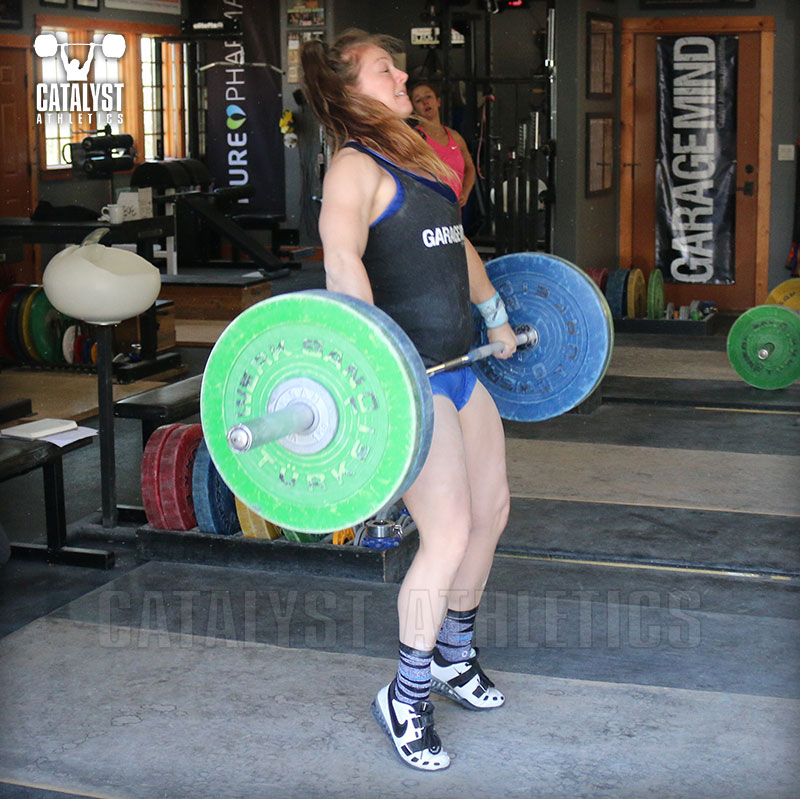Ask Greg: Issue 173

Patrick Asks: I have searched the internet, purchased several Olympic weightlifting books including Greg Everett's, and I can't find anything that covers this topic. Hoping you can shed some light! Do you have to have your feet in the pulling position for the Snatch and Clean, and then transition them to the receiving position? Or, can I start my setup with my feet in the receiving position, so I do not need to move them? I have been weightlifting for 10+ years and always transitioned my feet from pulling to receiving position until a few months ago. I have found with my feet already in the receiving position, I am much quicker under the bar and more stable. I know this is probably unconventional, but if I am hitting each position (power position, triple extension) can I get away with this type of lifting? Thanks for your time and consideration!
Greg Says: The short answer is that if it produces the best results for you, it’s the best way to do it. There are general rules that are such because they work best for the vast majority of athletes, but there are always exceptions to any of these rules.
In many cases, newer athletes will convince themselves that their non-standard way of doing something is better when it’s not accurate—they’re just more comfortable with what they do naturally because they haven’t yet invested the time to learning and practicing the standard way, and in most cases when they do, they discover they were wrong.
In your case, however, you’ve given the standard way 10 years, so that’s a pretty fair evaluation. If keeping your feet in the same place immediately improved your lifting, I’d stick with it.
Any time you’re trying to figure out if some technique is a good choice for you, remember that the one and only purpose of any technique is to maximize your ability to snatch and clean & jerk. In other words, the ONLY question that ultimately matters is Does this allow me to lift more weight reliably? The reliably part is important—don’t make some major technical change based on a single successful lift, because it may have been a fluke.
This having been said, I’d still caution you a bit—don’t stop evaluating how this footwork affects your lifts. If you start running into trouble down the line, you may need to make adjustments or even change back.
Keep in mind that the timing and fundamental motions of the lifts are the same whether or not you lift your feet. You have to drive through the ground the same way, continue driving to the same point relative to your body extension and pull under the bar, etc. See this video for some more on that.
Greg Says: The short answer is that if it produces the best results for you, it’s the best way to do it. There are general rules that are such because they work best for the vast majority of athletes, but there are always exceptions to any of these rules.
In many cases, newer athletes will convince themselves that their non-standard way of doing something is better when it’s not accurate—they’re just more comfortable with what they do naturally because they haven’t yet invested the time to learning and practicing the standard way, and in most cases when they do, they discover they were wrong.
In your case, however, you’ve given the standard way 10 years, so that’s a pretty fair evaluation. If keeping your feet in the same place immediately improved your lifting, I’d stick with it.
Any time you’re trying to figure out if some technique is a good choice for you, remember that the one and only purpose of any technique is to maximize your ability to snatch and clean & jerk. In other words, the ONLY question that ultimately matters is Does this allow me to lift more weight reliably? The reliably part is important—don’t make some major technical change based on a single successful lift, because it may have been a fluke.
This having been said, I’d still caution you a bit—don’t stop evaluating how this footwork affects your lifts. If you start running into trouble down the line, you may need to make adjustments or even change back.
Keep in mind that the timing and fundamental motions of the lifts are the same whether or not you lift your feet. You have to drive through the ground the same way, continue driving to the same point relative to your body extension and pull under the bar, etc. See this video for some more on that.
| Greg Everett is the owner of Catalyst Athletics, publisher of The Performance Menu Journal and author of Olympic Weightlifting: A Complete Guide for Athletes & Coaches, Olympic Weightlifting for Sports, and The Portable Greg Everett, and is the writer, director, producer, editor, etc of the independent documentary American Weightlifting. Follow him on Facebook here. |
Search Articles
Article Categories
Sort by Author
Sort by Issue & Date
Article Categories
Sort by Author
Sort by Issue & Date

